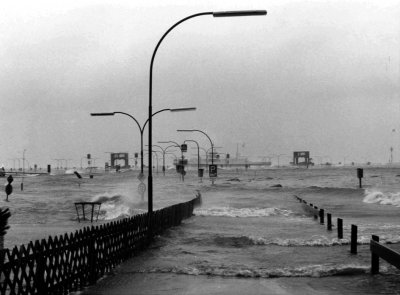Climate Change and North Sea Storm Surges
In the night from 16th to the 17th February 1962, the German North Sea coast was hit by a severe storm surge. The Hanseatic city of Hamburg was particularly badly affected. Entire districts of the city were submerged in water and more than 300 people lost their lives. Further severe storm surges were to follow this disaster. Similar climatic conditions can reoccur at any time. Scientists of the Institute of Coastal Research at the Helmholtz Center in Geesthacht are, therefore, observing storm surge activities in the German Bight extremely closely. According to currently available information, flood protection will retain its present effectiveness until approx. 2030; after this date, however, the situation will have to be reappraised.

In the night from the 16th to the 17th of February 1962, the dykes were severely damaged by a storm surge, as can be seen here at the Oldsumer Vogelkoje on the island of Föhr. Photo: Jann Corinth
The severity of storm surge levels on the German North Sea coast depends primarily on the rise in the sea level and wind climate conditions in the German Bight. Thus, on the basis of the rise in sea levels over the last 50 years alone, the storm surge of 1962 would be approx. 10 centimetres higher today. The wind climate, which also has an influence on storm surge levels, has remained unchanged in the meantime.
It was subject to strong fluctuations over the last century, but these are within the normal range. Today, the storms which occur in the German Bight during a stormy season are neither more severe nor more frequent than at the beginning of the last century. According to assessments made by scientists at the Institute of Coastal Research at the Helmholtz Center Geesthacht this may, however, change in the future.
Coastal researchers in Geesthacht have based their assumptions on a change in wind climate conditions and a further rise in the sea level. Thus, storm surges could be approx. 30 to 110 centimetres higher by the end of the century than they are today.

Severe storm surges also occurred after 1962. In 1976 the ferry dock in the harbour of Wyk auf Föhr was completely submerged by storm surge waves. Photo: Jann Corinth
The factors which determine the occurrence of storm surges are analysed in detail at the Geesthacht Institute of Coastal Research. As Prof. Dr. Hans von Storch, head of the Institute of Coastal Research explains: “We would like to know how and why the strength and frequency of storm surges has changed in the past. Moreover, we calculate scenarios for the future and talk to coastal communities about their perception of the dangers involved. We, thereby, gain a comprehensive picture for the German North Sea coast”.
A group of Geesthacht coastal researchers, together with engineers from the University of Siegen, has recently carried out an analysis of the rise in sea levels in the German Bight. All reliable water level measurements were evaluated for the first time, in order to determine how the mean sea level of the German Bight has changed. According to this evaluation, the sea level rose by approx. 20 centimetres in the last century, in recent times higher than in the years around 1960. However, similarly high increases in levels also occurred in the first half of the 20th century. They are, therefore, not unusual.
Even though continuous improvements in coastal protection have achieved a high level of protection nowadays, the population of North Germany regard storm surges as a great danger. Since 2008, the Institute of Coastal Research has been carrying out annual surveys to obtain the views of the citizens of Hamburg on climate change, storm surges and their perception of the dangers. For over 80 percent of the people of Hamburg, storm surges and floods are deemed to be the natural disasters with potentially the most serious consequences.
Prof. Dr. Hans von Storch will give a talk on the dangers of storm surges on the 50th anniversary of the 1962 storm surge.

Prof. Dr. Hans von Storch is director of the Institute of Coastal Research at the Helmholtz Center Geesthacht and a professor at the Meteorological Institute of the University of Hamburg. Photo: HZG
Sunday 12th February, 11 a.m.
Speech to open the special exhibition “1962 Storm Surge”
Tuesday, 14th February 19.30
Talk on: “Storm Surges on the German North Sea Coast. Can 1962 reoccur?”
Contact

Helmholtz-Zentrum Geesthacht
Phone: +49 4152 87-1677
E-mail contactMax-Planck-Straße 1
21502 Geesthacht
